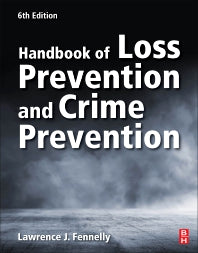Freshly Printed - allow 10 days lead
Couldn't load pickup availability
Handbook of Loss Prevention and Crime Prevention
Comprehensively examines -- and devises solutions for -- a wide variety of modern security threats, such as active shooter and terroristic threats
Lawrence J. Fennelly (Author)
9780128164594, Elsevier Science
Paperback, published 13 February 2020
544 pages, Approx. 100 illustrations
27.6 x 21.5 x 3.4 cm, 1.5 kg
Handbook of Loss Prevention and Crime Prevention, Sixth Edition, continues to serve as the preeminent, comprehensive resource for devising practical, modern solutions for securing people and property. The book presents the latest key applications for securing structures with Crime Prevention Through Environmental Design (CPTED), including plan review, report writing, presentation skills, lighting, zoning and behavioral management. Other sections address the latest issues related to active shooter situations, information technology, and international terrorism. Practical examples are provided, exploring applications for limiting retail crime and employing disaster readiness strategies. Edited by seasoned, trusted security practitioner Lawrence Fennelly, the book features contributions by some of the most well-known experts in the field. Readers will find this book to be a trusted resource for physical security professionals, students and certification candidates who must navigate, and make sense of, today’s most pressing domestic and international security issues.
1. Encompassing CPTED in 2020 and Beyond2. Designing Crime Risk Management3. Designing Security and Working with Architects4. Introduction to Vulnerability Assessment5. The Security Survey and The Audit6. Vulnerability Assessment Process Inputs Establish Protection Section A. Objectives7. Approaches to Physical Security and Deterrents8. Bringing CPTED into the 21st Century9. Environmental Criminology and Crime Control10. Problem Solving and Effective Community Policing11. Neighborhood Watch Guidelines for the Twenty-First Century12. Situational Crime Prevention and Opportunity Blocking Section B. Planning and Evaluation13. Design and Evaluation of Physical Protection Systems14. Planning, Management and Evaluation15. Crime Analysis16. Standards, Regulations, and Guidelines: Compliance and Your Security Programs, Including Global Resources and Master Plan Section C. Security Operations, Tools, and Technology17. Access Control, Access Badges and Biometrics Characteristics18. Intrusion Detection Systems19. Security Surveillance Systems20. Security Lighting Section D. Technology21. Information Technology Systems Infrastructure Section E. Delay22. Protective Barriers23. Physical Barriers24. Fences and Walls25. The Use of Locks in Physical Crime Prevention26. Safes and Vaults Section F. Response27. Today's Security Officer and SRO28. Bomb Threats29. Internal Theft Controls30. Safe Schools and Safe Campuses31. Domestic Violence: Can It Be Stopped32. Proprietary Information33. Identity Theft34. Retail Security & Employee Theft35. High Rise Building Security36. Multi-Residential Security37. Lodging Hospitality Security38. Emergency Management39. Cargo Theft and Cargo Security40. Soft Targets
Subject Areas: Forensic science [JKVF1]


